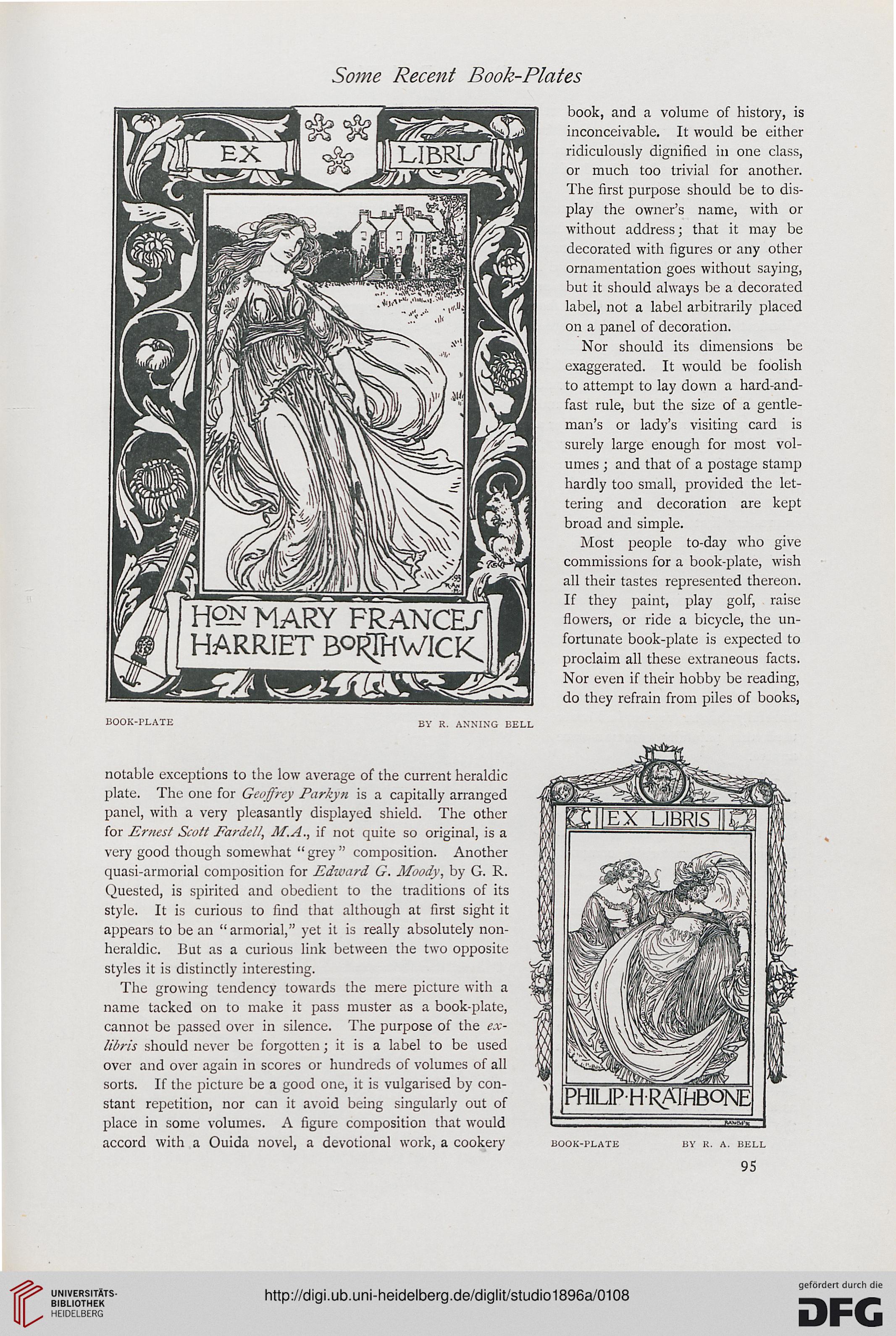Some Recent Book-Plates
book, and a volume of history, is
inconceivable. It would be either
ridiculously dignified in one class,
or much too trivial for another.
The first purpose should be to dis-
play the owner's name, with or
without address; that it may be
decorated with figures or any other
ornamentation goes without saying,
but it should always be a decorated
label, not a label arbitrarily placed
on a panel of decoration.
Nor should its dimensions be
exaggerated. It would be foolish
to attempt to lay down a hard-and-
fast rule, but the size of a gentle-
man's or lady's visiting card is
surely large enough for most vol-
umes j and that of a postage stamp
hardly too small, provided the let-
tering and decoration are kept
broad and simple.
Most people to-day who give
commissions for a book-plate, wish
all their tastes represented thereon.
If they paint, play golf, raise
flowers, or ride a bicycle, the un-
fortunate book-plate is expected to
proclaim all these extraneous facts.
Nor even if their hobby be reading,
do they refrain from piles of books,
hook-plate by r. an'nin'g bell
notable exceptions to the low average of the current heraldic
plate. The one for Geoffrey Parkyn is a capitally arranged
panel, with a very pleasantly displayed shield. The other
for Ernest Scott Fardell, M.A., if not quite so original, is a
very good though somewhat "grey" composition. Another
quasi-armorial composition for Edward G. Moody, by G. R.
Quested, is spirited and obedient to the traditions of its
style. It is curious to find that although at first sight it
appears to bean "armorial," yet it is really absolutely non-
heraldic. But as a curious link between the two opposite
styles it is distinctly interesting.
The growing tendency towards the mere picture with a
name tacked on to make it pass muster as a book-plate,
cannot be passed over in silence. The purpose of the ex-
libris should never be forgotten; it is a label to be used
over and over again in scores or hundreds of volumes of all
sorts. If the picture be a good one, it is vulgarised by con-
stant repetition, nor can it avoid being singularly out of
place in some volumes. A figure composition that would
accord with a Ouida novel, a devotional work, a cookery book-plate by r. a. bell
95
PHIL1PHRATHBONE
book, and a volume of history, is
inconceivable. It would be either
ridiculously dignified in one class,
or much too trivial for another.
The first purpose should be to dis-
play the owner's name, with or
without address; that it may be
decorated with figures or any other
ornamentation goes without saying,
but it should always be a decorated
label, not a label arbitrarily placed
on a panel of decoration.
Nor should its dimensions be
exaggerated. It would be foolish
to attempt to lay down a hard-and-
fast rule, but the size of a gentle-
man's or lady's visiting card is
surely large enough for most vol-
umes j and that of a postage stamp
hardly too small, provided the let-
tering and decoration are kept
broad and simple.
Most people to-day who give
commissions for a book-plate, wish
all their tastes represented thereon.
If they paint, play golf, raise
flowers, or ride a bicycle, the un-
fortunate book-plate is expected to
proclaim all these extraneous facts.
Nor even if their hobby be reading,
do they refrain from piles of books,
hook-plate by r. an'nin'g bell
notable exceptions to the low average of the current heraldic
plate. The one for Geoffrey Parkyn is a capitally arranged
panel, with a very pleasantly displayed shield. The other
for Ernest Scott Fardell, M.A., if not quite so original, is a
very good though somewhat "grey" composition. Another
quasi-armorial composition for Edward G. Moody, by G. R.
Quested, is spirited and obedient to the traditions of its
style. It is curious to find that although at first sight it
appears to bean "armorial," yet it is really absolutely non-
heraldic. But as a curious link between the two opposite
styles it is distinctly interesting.
The growing tendency towards the mere picture with a
name tacked on to make it pass muster as a book-plate,
cannot be passed over in silence. The purpose of the ex-
libris should never be forgotten; it is a label to be used
over and over again in scores or hundreds of volumes of all
sorts. If the picture be a good one, it is vulgarised by con-
stant repetition, nor can it avoid being singularly out of
place in some volumes. A figure composition that would
accord with a Ouida novel, a devotional work, a cookery book-plate by r. a. bell
95
PHIL1PHRATHBONE




